PF3D7_1323700 glideosome associated protein with multiple membrane spans 1 (GAPM1)
Disruptability [+]
| Species | Disruptability | Reference | Submitter | |
|---|---|---|---|---|
| P. falciparum 3D7 |
Refractory |
USF piggyBac screen (Insert. mut.) | USF PiggyBac Screen | |
| P. berghei ANKA |
Refractory |
RMgm-81 | Imported from RMgmDB | |
| P. berghei ANKA |
Refractory |
PlasmoGEM (Barseq) | PlasmoGEM | |
Mutant phenotypes [+]
None reported yet. Please press the '+' button above to add one.Imaging data (from Malaria Metabolic Pathways)
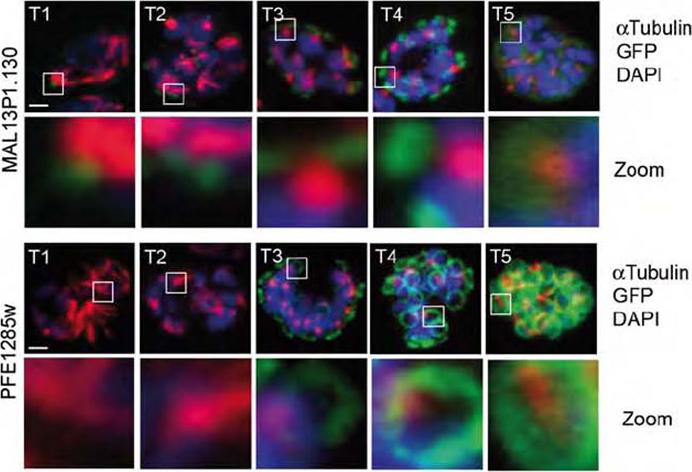
Co-localization of the TMD protein MAL13P1.130 and the alveolin PFE1285w with the disassembling spindle apparatus during schizogony (T1-5). Upper: While the mitotic spindles (T1, anti-tubulin, red) are still present, the cramp-like structure highlighted by the TMD protein MAL13P1.130-GFP is formed (T2). Lower: In contrast, the alveolin-defined structure only emerges after the spindles have retracted forming MTOC bundles (T3). Nuclei stained with DAPI. Scale bars, 2μm.Kono M, Herrmann S, Loughran NB, Cabrera A, Engelberg K, Lehmann C, Sinha D, Prinz B, Ruch U, Heussler V, Spielman T, Parkinson J, Gilberger TW. Evolution and Architecture of the Inner Membrane Complex in Asexual and Sexual Stages of the Malaria Parasite. Mol Biol Evol. 2012 29(9):2113-32.
See original on MMP
1. Co-localization of the TMD protein MAL13P1.130 and the glideosome associated protein GAP45. GAP45 was episomally expressed as mCherry fusion protein and localized in different schizont stages (left). Double transgenic cell line expressing MAL13P1.130-GFP and GAP45-mCherry reveals identical spatial distribution (right).2. Coexpression of the centrosome marker PfCentrin3-GFP and PF14_0578-mCherry shows a very close association between the forming IMC and the centrosome, as PfCentrin3 marks the centre of the developing IMC cramp-structure. Nuclei stained with DAPI. Scale bars, 2 μm.Kono M, Herrmann S, Loughran NB, Cabrera A, Engelberg K, Lehmann C, Sinha D, Prinz B, Ruch U, Heussler V, Spielman T, Parkinson J, Gilberger TW. Evolution and Architecture of the Inner Membrane Complex in Asexual and Sexual Stages of the Malaria Parasite. Mol Biol Evol. 2012 29(9):2113-32
See original on MMP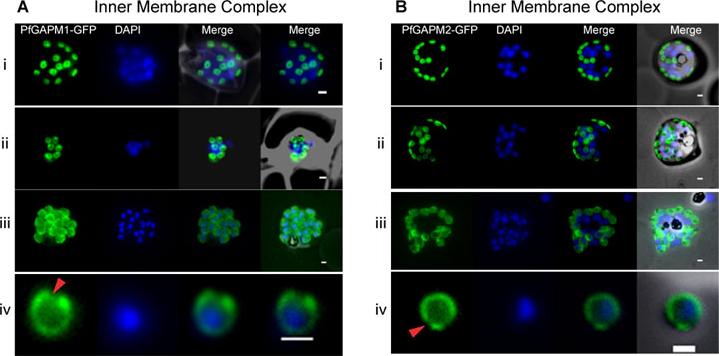
Live cell imaging of GFP tagged GAPMs (Glideosome Associated Protein with Multiple membrane spans) in Plasmodium falciparum indicate that they localize to the inner membrane complex. Developmental series of fluorescent images of live P. falciparum schizonts expressing PfGAPM1-GFP (A) or PfGAPM2-GFP (B) fusion proteins showing typical inner membrane complex morphology. During early schizogony, PfGAPM proteins are apparent as one or two small discs associated with each nucleus (i). Each disc is perforated by one or two small holes that may correspond to the future apical tip of the merozoite (ii). As the parasites mature the discs grow, ultimately encapsulating the mature merozoite except at the apical tip (red arrowhead) (iii,iv). Bullen HE, Tonkin CJ, O'Donnell RA, Tham WH, Papenfuss AT, Gould S, Cowman AF, Crabb BS, Gilson PR. A novel family of apicomplexan glideosome associated proteins with an inner-membrane anchoring role. J Biol Chem. 2009 284(37):25353-63.
See original on MMP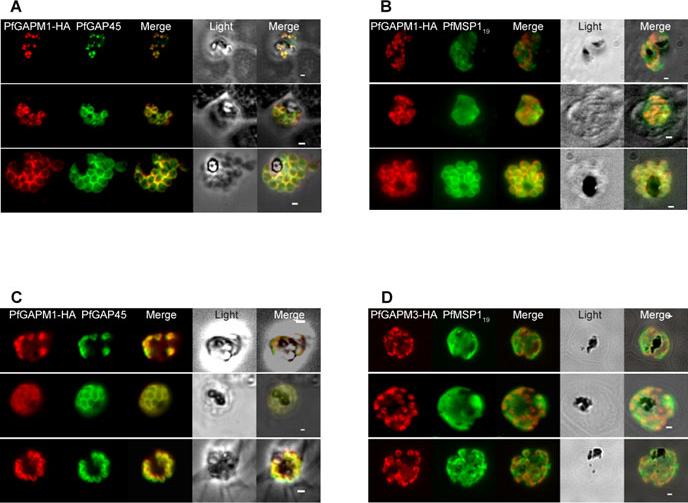
In Plasmodium falciparum the HA-tagged GAPMs (Glideosome Associated Protein with Multiple membrane spans) co-localise with the inner membrane complex protein GAP45 but not the plasma membrane protein MSP119. Immunofluorescence images of PfGAPM1-HA (A & B) and PfGAPM3-HA (C & D) expressing P. falciparum schizonts probed with an anti-HA antibody and antibodies to either the IMC-resident protein PfGAP45 (A & C) or the MSP119 subunit of the plasma membrane protein MSP1 PFI1475w (B & D). PfGAPM1-HA and PfGAPM3-HA co-localize with PfGAP45 PFL1090w throughout development but not with MSP119 particularly during early schizogony.Bullen HE, Tonkin CJ, O'Donnell RA, Tham WH, Papenfuss AT, Gould S, Cowman AF, Crabb BS, Gilson PR. A novel family of apicomplexan glideosome associated proteins with an inner-membrane anchoring role. J Biol Chem. 2009 284:25353-63.
See original on MMP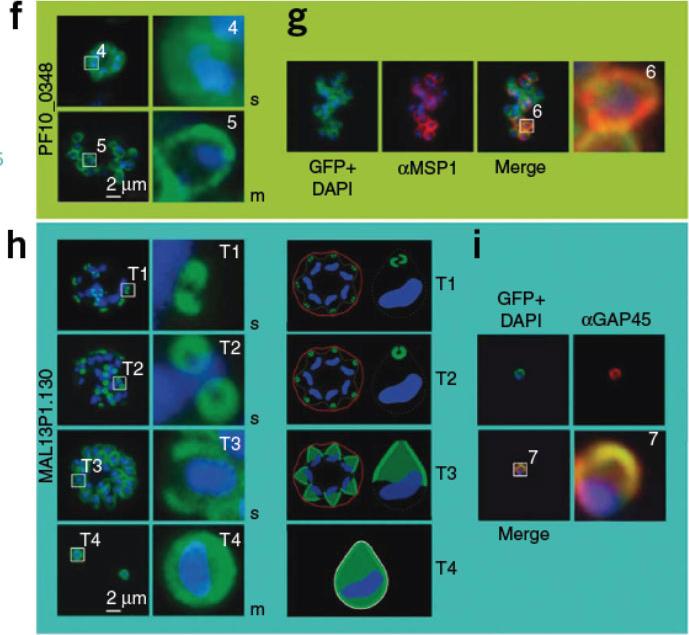
Boxed regions are numbered and depicted in higher magnification to the right. The nucleus is stained with DAPI (blue). f) PF10_0348-GFP (green) localized to the surface of schizonts and free merozoites in unfixed parasites. g) PF10_0348-GFP co-localized with the surface protein MSP-1 (red) in fixed parasites. Dynamics of MAL13P1.130-GFP (green) during schizogony in unfixed parasites. In early schizogony (T1), MAL13P1.130-GFP emerged as a cramp-like-structure at the apical tip of forming merozoites (h). This structure develops to be ring-like (T2) before becoming evenly distributed at the periphery of the nascent merozoite (T3-4). The third row shows a schematic representation. For confocal three-dimensional reconstitution,Hu G, Cabrera A, Kono M, Mok S, Chaal BK, Haase S, Engelberg K, Cheemadan S, Spielmann T, Preiser PR, Gilberger TW, Bozdech Z. Transcriptional profiling of growth perturbations of the human malaria parasite Plasmodium falciparum. Nature Biotechnol. 2010 28:91-8.
See original on MMP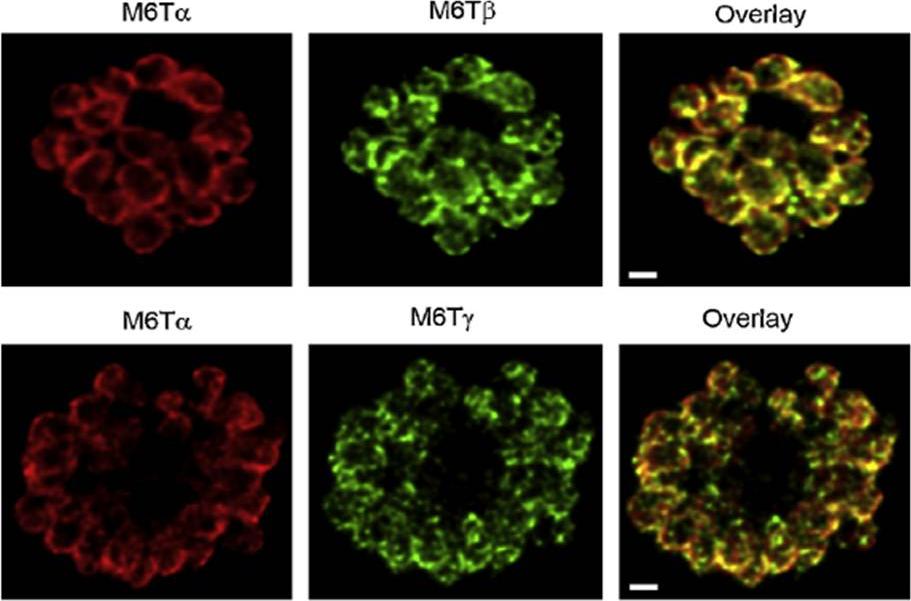
PfM6T proteins localize to the merozoite IMC. Confocal immunofluorescence images demonstrating location of each paralog, as indicated above each image. Images show a separate schizont-infected erythrocyte containing many merozoites; overlay of the red and green channels (rightmost column) shows colocalization of PfM6Ta with each other paralog. Red and green images reflect detection using specific antibodies raised in rabbits and mice, respectively. White scale bars represent 1mm.Rayavara K, Rajapandi T, Wollenberg K, Kabat J, Fischer ER, Desai SA. A complex of three related membrane proteins is conserved on malarial merozoites. Mol Biochem Parasitol. 2009 167:135-43. Copyright Elsevier 2010
See original on MMP
Upper panel: Co-localization of the group A protein PFD1110w (anti-PFD1110w, red) with the group B alveolin PFE1285w (PFE1285w-GFP, green) emphasizes the differential nature of the two structures in the nascent IMC and their spatial relation during the ongoing schizogony (T1-3). Nuclei stained with DAPI. Scale bar 2 μm.Lower panel: A double transgenic parasite line was generated expressing a different combination of proteins, MAL13P1.130-GFP (group A) and PF10_0039-mCherry. The dynamic distribution of these two members confirmed the spatial distinction but intimate proximity of the group A and group B defined IMC sub-compartments during the early phase of IMC biogenesis.Kono M, Herrmann S, Loughran NB, Cabrera A, Engelberg K, Lehmann C, Sinha D, Prinz B, Ruch U, Heussler V, Spielman T, Parkinson J, Gilberger TW. Evolution and Architecture of the Inner Membrane Complex in Asexual and Sexual Stages of the Malaria Parasite. Mol Biol Evol. 2012 29(9):2113-32
See original on MMP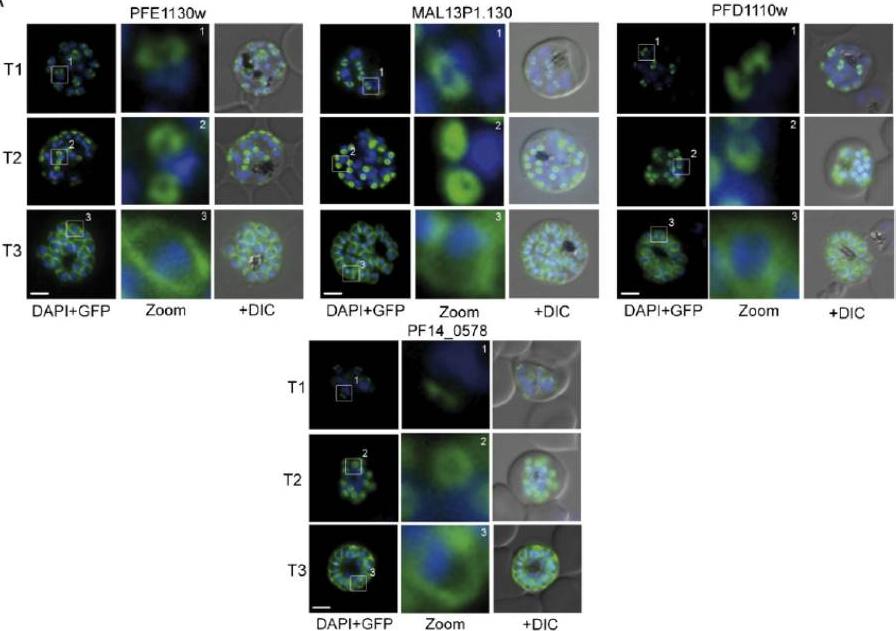
Several IMC proteins co-localize with GAP45 during schizogony. (A) Using GFP as a fluorescence tag, the TMD proteins PFE1130w, MAl13P1.130, PFD1110w, as well as PF14_0578 reveal three distinct structures during ongoing schizogony. Commencing as cramplike structures (T1), they transform to small ring-shaped formations (T2) that toward the end of schizogony expand and are then equally distributed underneath the plasma membrane (T3). Enlargement of these distinct structures are marked (white square) and shown in second row (Zoom) for each cell line.Kono M, Herrmann S, Loughran NB, Cabrera A, Engelberg K, Lehmann C, Sinha D, Prinz B, Ruch U, Heussler V, Spielmann T, Parkinson J, Gilberger TW. Evolution and architecture of the inner membrane complex in asexual and sexual stages of the malaria parasite. Mol Biol Evol. 2012 Sep;29(9):2113-32. PMID:
See original on MMP
Subcellular distribution of proteins predicted to be involved in invasion. All proteins were localized in schizonts (s) and free merozoites (m) using GFP-fusion proteins and grouped according to their predominant GFP localization: surface (green), inner membrane complex (turquoise),Hu G, Cabrera A, Kono M, Mok S, Chaal BK, Haase S, Engelberg K, Cheemadan S, Spielmann T, Preiser PR, Gilberger TW, Bozdech Z. Transcriptional profiling of growth perturbations of the human malaria parasite Plasmodium falciparum. Nat Biotechnol. 2010 28(1):91-8.
See original on MMP
IMC biogenesis during blood stage proliferation in P. falciparum. Schematic representation and live cell microscopy of the IMC dynamics during merozoite development (T0-T3). Two IMC proteins with distinct phenotypes where either tagged with GFP (the group A (classical glideosome components) protein MAL13P1.130, green) or mCherry (the group B protein (proteins of the Alveolin family as well as MAL13P1.228; appear as rings with a wider diameter surrounding the already established compartment) PF13_0039, red). T0: nascent IMC compartments visible as two dots in young schizonts. T1: IMC forms cramp-like structures. T2: IMC is enlarged and group B protein (red) emerges at the proximal rim; square: highlighting the spatial arrangement of group A and B proteins. T3: The IMC represented by group A and B proteins fully surrounds the mature merozoite.Kono M, Prusty D, Parkinson J, Gilberger TW. The apicomplexan inner membrane complex. Front Biosci (Landmark Ed). 2013 Jun 1;18:982-92. Review.
See original on MMPMore information
| PlasmoDB | PF3D7_1323700 |
| GeneDB | PF3D7_1323700 |
| Malaria Metabolic Pathways | Localisation images Pathways mapped to |
| Previous ID(s) | MAL13P1.130 |
| Orthologs | PBANKA_1338900 , PCHAS_1343500 , PKNH_1205100 , PVP01_1230900 , PVX_116685 , PY17X_1343600 |
| Google Scholar | Search for all mentions of this gene |